She was born in 1977 and grew up as a ketch. It was only after she met me that her life and her name changed, a bit like the wife I suppose.
People have asked why I decided to change a perfectly good ketch into a staysail schooner? This is a reasonable question and the answer is “Because I really wanted a brigantine”. A brigantine is traditionally a schooner with the foremast square-rigged and all other sails fore and aft. The name comes from the Brigands who pirated their trade along the Mediterranean Barbary Coast, which is what I might have to resort to after spending all my money on this boat!
Squaresails have been used on boats for centuries and when the wind is astern or a few points either side, it is still a very efficient way to propel a boat of any size, even today. Here is an explanation of why I wanted a brigantine schooner.
To me a brigantine is the ideal small boat cruising rig, the best of all worlds, capable of hauling tolerably close to the wind with its fore and aft sails; (although not as high as with an 85hp Perkins diesel); having fast reaching capabilities and unbelievable down-wind stability using the squaresail. Also, like a ketch the sails are divided into smaller manageable sizes.
Before I could make a brigantine, I first had to make a schooner.
I consulted two naval architects and an internationally renowned rigging expert. None could advise me, (or possibly more accurately, they didn't want to get involved), how to change a ketch to a staysail schooner never mind a brigantine. “Why don't you just buy a ready made schooner?” people asked and I certainly would have done that, but I could not find a suitable one within my budget. So if I couldn't buy one ready made the only option was to build one myself.
I eventually found a suitable boat on my own doorstep in Florida. She was a Down East 45 ketch, circa 1977/8, in a somewhat neglected condition, but which I could see had possibilities both for a rig change and also interior alterations, mainly through woodwork, that I enjoy doing with specialist wood like teak and walnut.
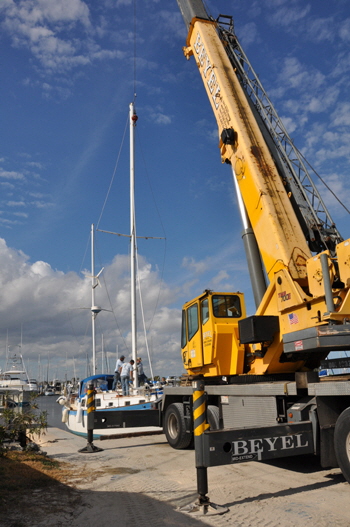 Changing the rig from a ketch to a schooner meant moving the positions of the existing main and mizzen masts, in fact, swapping them over so the mizzen went forward and the main aft. Then, just to complicate things, the forward mast is called the fore, but the after mast is still called the main. It also meant repositioning all the chainplates to the new rigging positions. Luckily these were simply bolted through the hull with stainless ½” inch bolts, and I changed them after the masts were lifted.
Changing the rig from a ketch to a schooner meant moving the positions of the existing main and mizzen masts, in fact, swapping them over so the mizzen went forward and the main aft. Then, just to complicate things, the forward mast is called the fore, but the after mast is still called the main. It also meant repositioning all the chainplates to the new rigging positions. Luckily these were simply bolted through the hull with stainless ½” inch bolts, and I changed them after the masts were lifted.
I had moved the boat to the lifting dock and removed the booms, loosened all the rigging screws from both masts and removed all other fixings. It had taken four days, but now we were ready for the big heave.
The massive mobile crane arrived promptly at 1.30 pm. A heavy hawser noose was slipped round the mainmast from the crane and the tension taken up. The crane operator indicated the load from his cab, one finger for each 1000 lbs of lift. He said it normally took between 1000 and 2000 lbs to break an old embedded through-deck-mast out of its step. However, we sailed right past 2000 to 3000 lbs and the only thing that happened was the boat lifted about 10 inches out of the water! I went below and whacked the mast with a hammer, hoping to break it free on its step. My helpers waggled the mast as best they could from on deck, but still nothing happened. The crane operator said it was my call, if I wanted to go to a greater load, because his crane was capable of lifting the whole 22 ton boat out of the water if necessary!
I decided to try one more 1000 lb heave, but even at two tons of lift there was still absolutely no movement in the mast, except the boat lifted even higher. I had visions of pulling the mast and half the keel out of the bottom of the boat, so I chickened out and stopped the lifting.
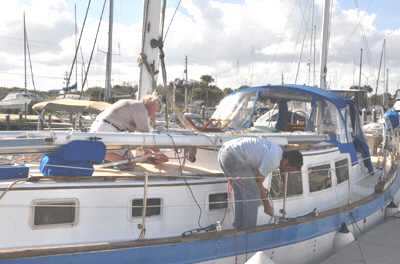 After some deliberation I decided that drastic results require drastic action. A crowd had gathered by this time, (don't they always), and were astonished when I appeared on deck with the hefty electric reciprocating saw fitted with a 10” inch metal cutting blade, then started to merrily saw the mast in half at deck level. It must have looked very strange, but what the onlookers didn't know was that I intended to have the mast finish at deck level anyway, then splice it to a compression post down to the keel.
After some deliberation I decided that drastic results require drastic action. A crowd had gathered by this time, (don't they always), and were astonished when I appeared on deck with the hefty electric reciprocating saw fitted with a 10” inch metal cutting blade, then started to merrily saw the mast in half at deck level. It must have looked very strange, but what the onlookers didn't know was that I intended to have the mast finish at deck level anyway, then splice it to a compression post down to the keel.
The crane took the weight and as the last cut went through the mast broke free and lifted a mere 3” inches. The rest was outside my control as the yard crew lowered the swaying stick on to the fork truck arms, and off it went to be laid down on already prepared trestles. Next, the mizzen was easily lifted off its deck-stepped location and laid next to the main. The whole operation only took two hours, but it seemed longer to me and I was very relieved when it was over.
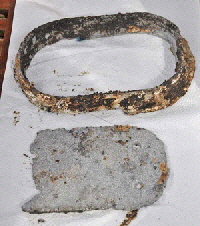 After the crane departed and we had tidied up back at our berth, I then had to think of a way to pull the remaining mast section out of the boat. It was suggested I pour half a gallon of mercuric acid down the pipe in the hope it would dissolve the corrosion that was the only thing gluing the mast to the keel. For a while the boat looked like it had a steam engine, with fumes coming out of the mast smoke stack sticking out of the deck.
After the crane departed and we had tidied up back at our berth, I then had to think of a way to pull the remaining mast section out of the boat. It was suggested I pour half a gallon of mercuric acid down the pipe in the hope it would dissolve the corrosion that was the only thing gluing the mast to the keel. For a while the boat looked like it had a steam engine, with fumes coming out of the mast smoke stack sticking out of the deck.
After a few hours I set up two large wooden blocks each side of the mast then placed my heavy trolley jack across the gap. I drilled holes at either end of the mast stub and shackled a strong chain from one hole to the other and over the lifting end of the jack. It was then just a question of pumping the jack until something happened. It is a 2000 lbs jack and it took all of that to break the joint at the mast step, that finally separated with a indifferent ‘pop,’ and the corrosion brute was beaten. The reason the jack was able to break the joint at a lower pressure than the crane was because it was actually pulling the mast up between the rigid deck and the immovable keel, whereas the crane was relying on the weight of the boat to separate the joint and that was partially floating.
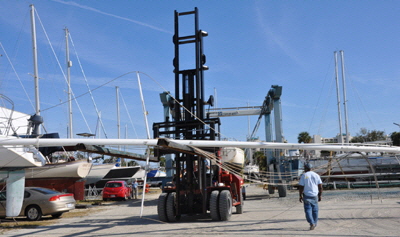 I and a paid helper worked on and off on both masts and their booms for six months. First stripping them of all attachments, winches, rigging, wiring, radar, wind generator, spreaders, lamps, etc. All the old paint was then stripped off, that was no small job for a 57’ foot mast. Brackets were then welded on to take the new rigging and stays.
I and a paid helper worked on and off on both masts and their booms for six months. First stripping them of all attachments, winches, rigging, wiring, radar, wind generator, spreaders, lamps, etc. All the old paint was then stripped off, that was no small job for a 57’ foot mast. Brackets were then welded on to take the new rigging and stays.
The mainmast would now came through the saloon, but I didn't want a 10” inch by 7” inch mast obstruction right in the middle of the cabin, so I spliced a 4” inch square compression post to the mast using splicing pieces supplied by the mast maker. This extended the mast by 11’ feet to the bottom of the boat where it locates in a heavy wide stainless steel spreader plate I had made, directly on the Keelson floor.
The new foremast stepped forward of where the ketch mainmast had been, so I made a new mast step by pouring industrial cement into a wooden mold directly on to the keelson. I also extended the foremast height by 8’ feet to produce a wider slot between the jib and fore staysail. The taller foremast also increased the jib luff by some 8’ feet that improves her upwind performance. I also needed a taller foremast to be able to carry a second Raffee topsail above the fore-course if ever I got round to it in the future. The foremast was extended with a length of the same section, using splices. The lower squaresail of any boat is called the Course, consequently the squaresail on Britannia is the fore-course.
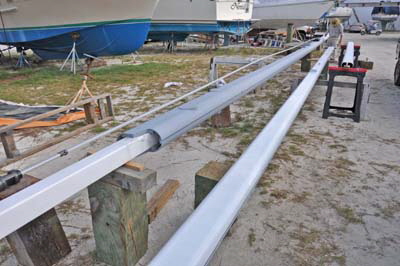 All the spars were then repainted firstly with aluminum primer undercoat then two coats of undercoat, then about seven layers, (I actually forgot how many), of Navy Blue two-part polyurethane from Interlux paints. The original spreaders were made of spruce and very worn and cracked so I bought longer aluminum spreaders for both masts. The spreaders on the foremast were also raked back 30 degrees to allow for bracing the yard.
All the spars were then repainted firstly with aluminum primer undercoat then two coats of undercoat, then about seven layers, (I actually forgot how many), of Navy Blue two-part polyurethane from Interlux paints. The original spreaders were made of spruce and very worn and cracked so I bought longer aluminum spreaders for both masts. The spreaders on the foremast were also raked back 30 degrees to allow for bracing the yard.
I then fitted the Facnor roller furling system to the back of the mainmast, that converted it into a roller furling mainsail. Originally only the jib was roller furled but I wanted to control all sails from the safety of the cockpit, so I also converted both the fore staysail and the ‘tweenmast staysail to roller furling. That made all five sails roller furling including the squaresail.
I also riveted aluminum climbing steps all the way up both masts at 20” inch centers with a double step near the top. These do increase windage, but they are so convenient for single handed mast work.
I never thought it would be over a year before we slid the masts back into their new locations. Actually, the work didn't take that long, because in the middle of Florida's summer when it was simply too hot to work outside I decided to leave them in the yard. Having air conditioning inside the boat made it more sensible to work inside, and we weren't going anywhere anyway, we had no masts.
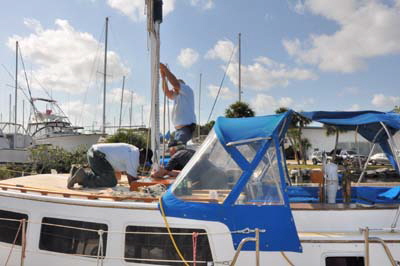 Re-stepping both masts was basically the reverse of lifting them and went relatively smoothly with much less stress. Britannia is registered as a British vessel so I placed the traditional antique British penny under both masts before they were lowered on to their mast step.
Re-stepping both masts was basically the reverse of lifting them and went relatively smoothly with much less stress. Britannia is registered as a British vessel so I placed the traditional antique British penny under both masts before they were lowered on to their mast step.
One thing that concerned me was whether the boats balance would change by switching the mast positions, but nothing was perceptible at the waterline after both masts were in place. There are advantages in having a heavy long keel cruising boat with a 14’ foot beam. You can add more or less any weight without ill effect.
Initially the masts were stayed with ropes in place of the steel rigging that had yet to be measured and ordered. To do this I had to go up both masts and measure from each wire attachment point down to their turnbuckles. The original wires were 5/16” inch and 1/4” inch, but I ordered new wires using 3/8” inch stainless throughout. I had also installed twin mainmast backstay chainplates, instead of the single one for the original mizzen. I believe in a belt-and-braces approach for an ocean cruising boat.
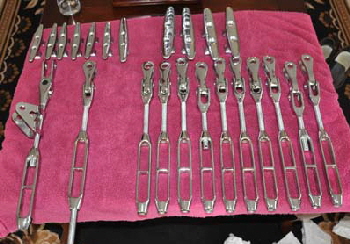
 While waiting for the standing rigging to be delivered I had all the rigging screws and turnbuckles chrome plated, along with all the winches and cleats. These were then bolted to the masts.
While waiting for the standing rigging to be delivered I had all the rigging screws and turnbuckles chrome plated, along with all the winches and cleats. These were then bolted to the masts.
Within a few weeks the new wires arrived and I was hoisted up the mast a dozen or so times bolting them in place. Thank goodness for the new Maxwell electric windlass, that made the job effortless for the deck crew.
Eventually, with both masts securely stayed the day came to hoist the yard that had been sitting in my daughters factory in Hickery, North Carolina, for over a year. I transported it 650 miles to the boat on a special wooden extension framework I fitted on the roof-rack of my van. It is 25” feet long, and stuck out 6’ feet in front and 3’ feet in the back of my van.
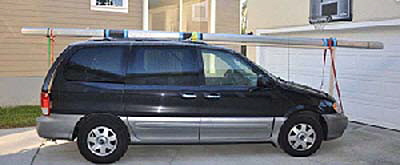 With help I finally maneuvered the long yard into position across the boat and set up the various control lines. Then up she went on the track I had riveted to the front of the mast. The combined yard and sail weighed 135 lbs. but it was easy using the windlass.
With help I finally maneuvered the long yard into position across the boat and set up the various control lines. Then up she went on the track I had riveted to the front of the mast. The combined yard and sail weighed 135 lbs. but it was easy using the windlass.
There are nine control lines for the yard and the course: a hoist at the gooseneck; a lift each side; braces each side; two lines for the sail furling mechanism, and two sheets from the clews of the sail. All these lines had to have running blocks attached to their respective mast lugs, lines rove and cleats attached to the masts to secure them.
To separate and identify all the lines coming down the masts I made four teak pinrails and turned sixteen belaying pins on a lathe. These make for a very clean deck with no loose lines lying around and also add an air of traditionalism to an otherwise modern boat.
We discovered another advantage of having a yard on the foremast. If the skipper and crew fancy a Gin & Tonic about noon, but the sun is still not yet over the yardarm we just lower the yard a bit - problem solved.
The red cross on the Fore-Course is The Cross of St. George on the English flag that forms part of the Union Jack. It is also the Templar’s Cross and the emblem of the Red Cross Association. But that just adds to the mystery when my little tall ship is first spotted on the horizon
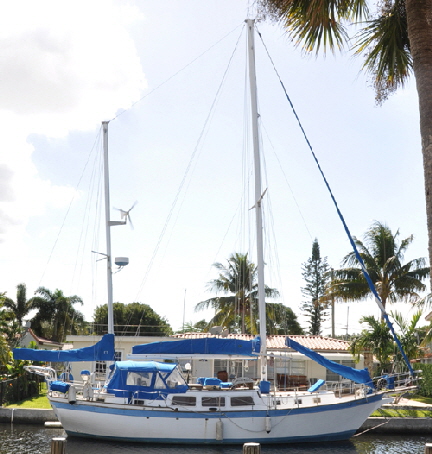
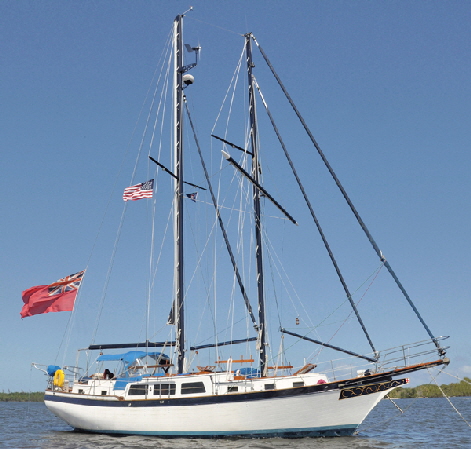
BEFORE AFTER